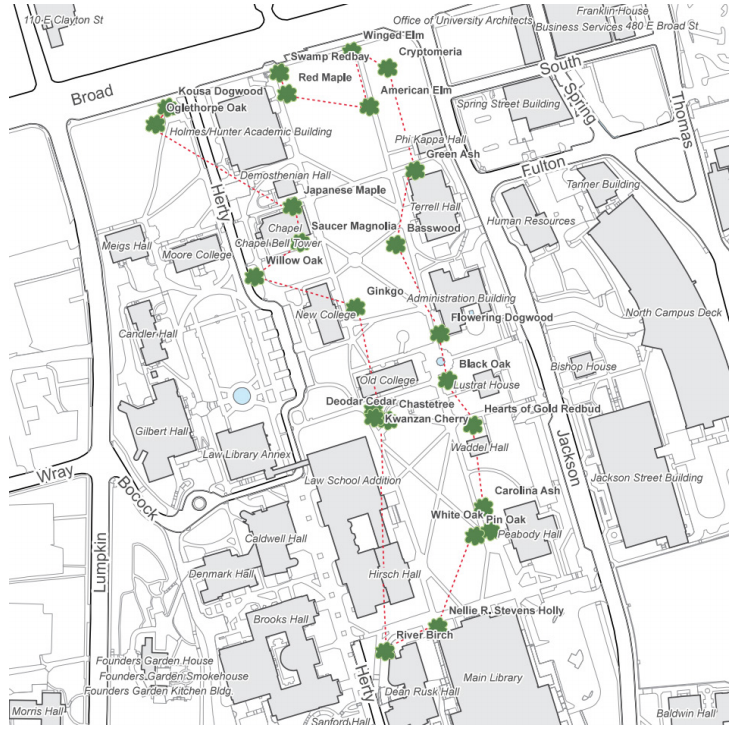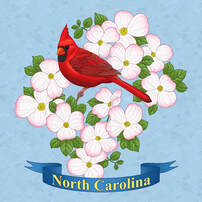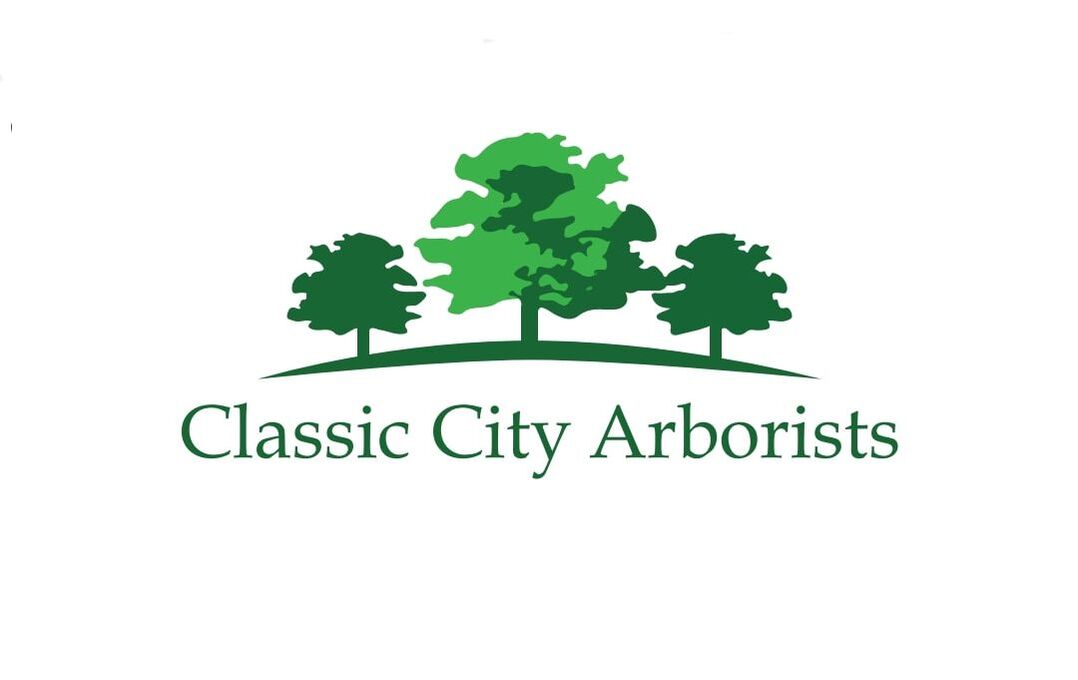|
News and Blog Articles
|
|
Last week, we talked about the UGA Campus Arboretum. An arboretum is a botanical garden that predominantly features trees. The UGA Campus Arboretum, as the name suggests, includes the entire UGA campus. Basically, all the trees and plants on campus are part of the Arboretum! There are certain trees that receive a little special treatment, however. Trees of historic, local, and botanical value, as well as a few stately specimens are identified with small black plaques that denote their species with the UGA Campus Arboretum logo. If you’re looking to seek out these special trees, you can do so by following one of the many Arboretum tours. This week, we’ll be going through the North Campus Tour, which features 24 trees. North Campus is the most historic section of UGA’s campus, and includes landmarks such as The Arch and the Holmes-Hunter Academic Building. To start, here’s what the route looks like: You can visit these trees in any order you want, really, but here’s the Arboretum’s suggestion: 1. Red Bay - Persea palustrisThe first stop on this tour is a large, multi-trunked Red Bay located just behind and to the left of The Arch (facing towards campus and the Holmes-Hunter Academic Building). This Red Bay was planted here specifically to commemorate the Ancient Egyptian tradition of planting persea trees at the entrance of their educational institutions. The Arch represents the entrance to the University, and so, Persea palustris was planted. 2. Red Maple - Acer rubrumKnown for their brilliant fall foliage, Red Maples are one of the most common hardwoods in North America. Check out our Tree of the Month article to learn more about Red Maples! 3. American Elm - Ulmus americanaAmerican Elms were once used as “meeting trees” to designate gathering spots by the Native Americans, and then later by the Sons of Liberty in the American Revolution. 4. Winged Elm - Ulmus alataWinged Elms get their name from the cork-like “wings” that form along branchlets. 5. Cryptomeria - Cryptomeria japonicaThis large evergreen conifer is viewed as sacred and often planted around temples and shrines in its native Japan, where it is the national tree. 6. Green Ash - Fraxinus pennsylvanicaThis native species is the most widely distributed across North America, and its high volume of seeds every year are an important food source for local wildlife. 7. American Basswood - Tilia americanaThe American Basswood is especially popular with bees, and lends a distinctive flavor to honey produced from its flowers, called basswood honey. 8. Flowering Dogwood - Cornus floridaA “four-season” tree, the Flowering Dogwood is known for its spectacular pink and white flowers in spring, its bright red berries in the fall, followed by a brilliant red fall foliage display. The mottled bark is also attractive when the tree is bare during winter months. 9. Black Oak - Quercus veluntinaThe common Black Oak prefers to grow on slopes, making it a good choice for erosion prevention. This particular tree grows the largest leaves of any oak on UGA’s campus! 10. Hearts of Gold Redbud - Cercis canadensisWith its pretty pink flowers and smaller stature, this decorative tree is a perfect addition to any landscape. The Hearts of Gold Redbud is also the state tree of Oklahoma. 11. White Oak - Quercus albaWhite Oaks are another wide-spread species in the eastern US, and are known for their hardiness against a range of climates and even wildfires. Check out our Tree of the Month article to learn more about White Oaks! 12. Pin Oak - Quercus palustrisThe branches of the Pin Oak are often described as pin-like, which is where this native, flood-tolerant species gets its name. 13. Nellie R. Stevens Holly - Ilex x 'Nellie R. Stevens'This hybrid species is named after Nellie Robinson Stevens, who pilfered a few pollinated English holly berries, only to have bees cross-pollinate them with a Chinese holly in a chance encounter that created an entirely new species! Check out our Tree of the Month article to learn more about Nellie R Stevens Hollies! 14. River Birch - Betula nigraRiver Birches are characterized by their “exfoliating” bark, which peels off in delicate, papery curls and leaves behind a mottled color pattern. Check out our Tree of the Month article to learn more about River Birches! 15. Chaste Tree - Vitex agnus-castusNative to Mediterranean regions of Europe and Asia, this ornamental tree features delicate foliage and lilac summer flowers that are especially attractive to butterflies. 16. Deodar Cedar - Cedrus deodaraNicknamed “the wood of the gods,” the Deodar Cedar is the national tree of Pakistan, and is native to the Himalayas and northern Africa, where it is considered sacred and often worshipped. 17. Kwanzan Cherry - Prunus serrulataA cultivar of the ornamental cherry tree, the Kwanzan Cherry was gifted to the United States by Japan in 1912. It gained popularity after being displayed at Washington DC’s annual Cherry Blossom Festival. 18. Ginkgo - Ginkgo bilobaThe Ginkgo, also known as the “fossil tree,” is the sole survivor of the Ginkgo genus. 19. Willow Oak - Quercus phellosThanks to their adaptability, Willow Oaks are a popular choice for landscapers and homeowners alike. Check out our Tree of the Month article to learn more about Willow Oaks! 20. Saucer Magnolia - Magnolia x soulangeanaA cross between Magnolia denudate and Magnolia liliiflora, the Saucer Magnolia is one of the most important magnolias in horticulture. These valued ornamental trees are loved for their large pinkish-white blooms with vibrant pink and purple stripes on their underside. 21. Japanese Maple - Acer palmatumJapanese Maples have a range of natural genetic divergences, and have also been cultivated into many different cultivars, leading to a wide array of distinct variations. 22. Robert Toombs OakThis stop doesn’t actually include a tree. Instead, it features a plaque that details the legend of the Robert Toombs Oak. In 1828, Robert Toombs gave a speech under a great oak tree. The speech was so eloquent and powerful that the entire commencement audience came out of the Chapel to listen. Upon the hour of his death years later, the same oak was supposedly struck by lightning. The charred remains of that tree are what is now called Toombs Oak. 23. Oglethorpe Oak - Quercus oglethorpensisThe Oglethorpe Oak is a rare species, currently classified as endangered, that was discovered in Oglethorpe County. Its name is meant to honor both the county and James Oglethorpe himself, the man who founded Georgia. 24. Kousa Dogwood - Cornus kousaNative to Japan, Korea, and China, the Kousa Dogwood is very similar to the US-native Flowering Dogwoods. It can be identified by the more pointed petals and attractive exfoliating bark. There you have it! The North Campus Tour. Stay tuned next week as we go through everything the Central Campus Tour has to offer! AuthorEmily Casuccio is sister and sister-in-law to Rebekah and Scott Rushing, and has over half a decade of experience in copywriting, copyediting, proofreading, and developmental storyboarding. She's worked with both published and undiscovered authors on both fiction and nonfiction, and takes pride in supporting local businesses. Her passion lies in the written word and helping authors of all capacities realize their dreams and achieve their fullest potential. To learn more about her, read samples of her work, or contact her, visit her online portfolio.
0 Comments
If you’ve ever been on UGA’s campus, then you’ve surely seen the stunning array of trees and other flora decorating the landscape. These natural wonders are more than just pretty embellishments – they’re a part of the University of Georgia Campus Arboretum. What’s an arboretum?It sounds pretty fancy, but an arboretum is just a fancy word for a botanical garden that’s specifically devoted to trees. So, while places like the State Botanical Garden of Georgia definitely have their fair share of trees, arboreta feature trees as the majority. Where is the University of Georgia Campus Arboretum?While most arboreta and botanical gardens are set up like a park, with an entrance and exit and clearly-defined walking paths, the UGA Campus Arboretum encompasses the entirety of UGA’s campus! Any land that is owned and maintained by the University of Georgia is a part of the UGA Campus Arboretum. Why did UGA dedicate its entire campus as an arboretum?The University of Georgia has always played an active role in caring about the environment, and an important part of advocating for nature is helping it grow! Prior to the Campus Arboretum, UGA established a few smaller arboreta in designated locations. Unfortunately, these attempts succumbed to development as the University grew. In order to create an arboretum that could be protected, the decision was made to declare the entire campus one. Rather than funding the maintenance of a specific plot of land as an homage to trees, the University puts those efforts into the Arboretum Committee. In turn, the committee ensures all of UGA’s landscaping falls in line with the Campus Arboretum’s mission: “…to provide biologically diverse and aesthetic collections of trees, shrubs, and herbaceous plants in designed settings for the enjoyment and education students, staff, faculty, and visitors, and to map, label, and otherwise promote the extant and future tree and shrub collections.” This mission ensures that the trees planted on campus are well cared for, and that more trees (and shrubs and herbaceous plants) are incorporated into the landscape as often as possible. The result of this is that the entire University campus is a beautiful museum of all that nature has to offer! How to Enjoy the UGA Campus ArboretumWhether you’re a student, faculty member, visitor, or just a passerby, the Campus Arboretum is for everyone. You can take a walk through the grounds yourself to see the sights. Featured trees will have a small black sign at their base that declares them a part of the Campus Arboretum and denotes their species. But, if you’re interested in a more structured tour, the University of Georgia Campus Arboretum website has guides for all the different sections of campus: North Campus, Central Campus, South Campus, the Founder’s Garden, and the Oconee Forest Park. You can download and print a copy of the North Campus Walking Tour map for a list of featured trees paired with hand-drawn leaf examples. Or, you can take a virtual tour of each campus section, where you’ll find pictures of featured trees and more relevant information. Stay tuned as over the next few weeks, we take some time to shine a spotlight on the different campus tours, what trees you can expect to see, and what makes those trees special! AuthorEmily Casuccio is sister and sister-in-law to Rebekah and Scott Rushing, and has over half a decade of experience in copywriting, copyediting, proofreading, and developmental storyboarding. She's worked with both published and undiscovered authors on both fiction and nonfiction, and takes pride in supporting local businesses. Her passion lies in the written word and helping authors of all capacities realize their dreams and achieve their fullest potential. To learn more about her, read samples of her work, or contact her, visit her online portfolio. Our newest Tree of the Month is, in our humble opinion, one of the prettiest trees we’ve ever seen: the flowering dogwood. Also known as the Florida dogwood, St. Peter’s Crown, and just plain-old Dogwood, Cornus florida is most well-known for its large, showy “flowers.” We put that in quotations because what most people would consider the dogwood’s flower is actually four bracts, or modified leaves. These four bracts can be stark white to deep pink in color, and usually have a dimple on their outer edge that causes them to curl into a point. The true flowers of the dogwood are the little green clusters in the center of the four bracts, often mistaken for stamen or pollen pods. From one end to the other, the bracts measure around 3 inches long on average, making them larger than most tree flowers. As the “flowers” of the dogwood are actually bracts, they last much longer than typical flowers do, and can bloom as long as May all the way through October. In addition to this long flowering season, dogwoods also offer beautiful color displays throughout the year, making them a favorite of landscapers and homeowners alike. Long, handsome dark-green leaves herald in the warmer months prior to flowering season. In the fall, these leaves change to brilliant scarlet reds and deep mahogany purples. Small, glossy-red berries offer more months of color, and attract a range of winter birds and small animals. And when the tree is fully bare, the pretty speckled bark is revealed. Dogwoods can naturally be both single- and multi-trunked, and with a little cultivating, you can encourage your tree to either. Typically, dogwoods grow as wide as they do tall, with a full, spreading crown of nearly horizontal branches. Most dogwoods will stay on the smaller side, reaching heights between 20 and 30 feet tall (though some have been recording surpassing 40 feet!). When it comes to caring for these native trees, dogwoods are relatively low-maintenance. They are both heat- and cold-tolerant, so they can handle the scorching summers and occasional freezes of the South. On a regular day, they prefer partial shade, which means around 4 hours of direct sunlight. Though the roots need to be kept cool and moist, the tree itself doesn’t need constant watering. The best way to help out a dogwood is by adding a few inches of mulch around the base to protect the roots from drying out. Otherwise, the natural rain patterns and sun levels of Georgia will get the job done. If you’re thinking of planting your own flowering dogwood, be sure to keep its sun requirements in mind, but there isn’t much else to worry about otherwise. In the wild, flowering dogwoods are often found growing beneath larger forest trees. Their root systems don’t mind sharing, and their growth pattern can accommodate height restrictions. As a bonus, these trees have a moderate growth rate of 13 to 24 inches a year, so you won’t have to wait too long to enjoy those gorgeous “flowers!” AuthorEmily Casuccio is sister and sister-in-law to Rebekah and Scott Rushing, and has over half a decade of experience in copywriting, copyediting, proofreading, and developmental storyboarding. She's worked with both published and undiscovered authors on both fiction and nonfiction, and takes pride in supporting local businesses. Her passion lies in the written word and helping authors of all capacities realize their dreams and achieve their fullest potential. To learn more about her, read samples of her work, or contact her, visit her online portfolio. There’s nothing quite as refreshing as enjoying fresh fruit in the heat of summer. And fruit doesn’t get any fresher than when it’s just been picked straight from the tree! Fruit trees are notorious for being difficult to maintain, and many would-be fruit enthusiasts end up disappointed when all their hard work doesn’t yield any…well…fruit. And don’t get us wrong, fruit trees aren’t easy. They’re pretty high-maintenance, and can be fickle, especially in the temperamental temperatures of Georgia summers and winters. But, for those willing to put in the elbow grease, here’s a list of some handy tips on how to grow fruit trees in Georgia! Social DistancingFruit trees need a lot of nutrients in order to actually grow fruit. If you plant fruit trees too close to each other, their roots will end up competing for resources, which will weaken all the trees involved. Room to GrowWhen you dig a hole to plant your tree, make it about twice as wide as the root ball or tree’s container. You’ll fill this in with nutrient-rich soil, of course, but doing this loosens the ground around the roots so they have an easier time spreading. This gives your tree a much better chance of successfully establishing itself. Fun in the SunWhile the summer heat isn’t always the best thing for fruit trees, they definitely need sun exposure. Be sure to choose a full-sun location (6 to 8 hours of direct sunlight every day). Don’t Forget DrainageFruit trees definitely need a lot of water, but they also don’t like their soil to be sopping wet. A well-drained area will ensure that any excess liquid won’t stick around to rot the roots. Pro Tip – a good way to ensure good drainage is to plant on a slope or incline! The Watering Sweet SpotMost fruit trees will need about 3 inches of water per month. That’s a hard measurement to calculate as far as how much you should water, but a good rule of thumb is to use your thumb. Stick your thumb into the dirt near the base of your tree. If the dirt is dry as far as your thumb can reach, then it’s time to water. Birds of a FeatherFruit trees can’t pollinate properly unless there are multiple different varieties of that tree around for cross-pollination. Be sure to plant at least 2 (but preferably more) varieties of whatever fruit tree you choose. Pro Tip – plant a range of different fruit trees (in addition to different varieties of the same fruit) for best results! What fruit trees grow best in Georgia?Most fruit trees will grow in Georgia with some love, but the best fruit trees for Georgia are:
AuthorEmily Casuccio is sister and sister-in-law to Rebekah and Scott Rushing, and has over half a decade of experience in copywriting, copyediting, proofreading, and developmental storyboarding. She's worked with both published and undiscovered authors on both fiction and nonfiction, and takes pride in supporting local businesses. Her passion lies in the written word and helping authors of all capacities realize their dreams and achieve their fullest potential. To learn more about her, read samples of her work, or contact her, visit her online portfolio. Sources:
How Much Water Should One Give a Fruit Tree? How to Grow Fruit Trees in Georgia UGA Extension: Growing Fruits UGA College of Agricultural and Environmental Sciences Best Fruit Trees to Grow in Georgia Fruit Trees for Zone 8 Georgia Grown: Fruits Planting a Small Home Orchard Bare Root Fruit Trees Fruits to Grow in Your Garden Planting and Caring for Fruit Trees |
Categories
All
Archives
January 2023
|
|
23 Whatever you do, work at it with all your heart, as working for the Lord, not for human masters,
24 since you know that you will receive an inheritance from the Lord as a reward. It is the Lord Christ you are serving.
Colossians 3:23-24
24 since you know that you will receive an inheritance from the Lord as a reward. It is the Lord Christ you are serving.
Colossians 3:23-24



